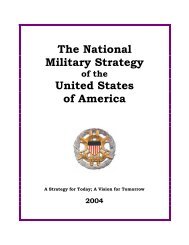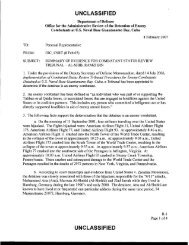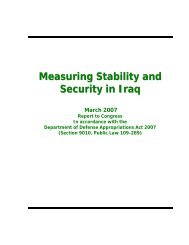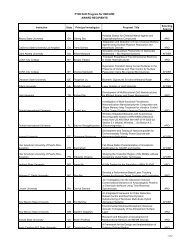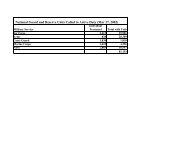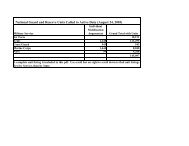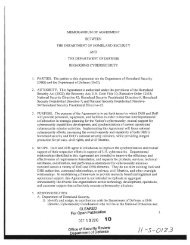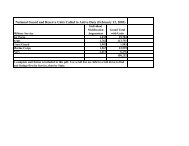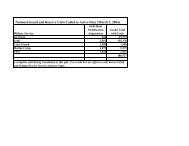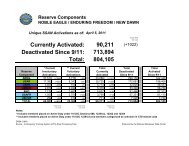Report - United States Department of Defense
Report - United States Department of Defense
Report - United States Department of Defense
You also want an ePaper? Increase the reach of your titles
YUMPU automatically turns print PDFs into web optimized ePapers that Google loves.
UNCLASSIFIED<br />
Approximately 60 percent <strong>of</strong> APRP funds are devoted to Community Recovery projects<br />
delivered through small grant projects (SGPs) and Line Ministry programs. To date, the<br />
implementation <strong>of</strong> 136 SGPs has been administered through the JS and PJSTs. In addition, 817<br />
APRP projects have been executed by the Line Ministries. MAIL, MoPW, MoLSAMD, and<br />
MRRD have dedicated cells to ensure synchronization with the JS initiative.<br />
Any Anti-Government Element (AGE) interested in the APRP may make initial contact with<br />
GIRoA, the ANSF and ISAF or through a trusted third party. The AGE will begin the interview<br />
process with the Provincial Governor (PGOV), PPC, NDS, and/or ANSF. During this time, the<br />
insurgent negotiates the terms for his pending entry into the program. Grievance resolution,<br />
position/status within the insurgency, plans for other AGEs to join with him, and types <strong>of</strong><br />
weapons that he is prepared to turn in or register are just some <strong>of</strong> the topics discussed at this<br />
time. The community to which the potential reintegree wishes to return is also involved in the<br />
discussion and will inform the PPC <strong>of</strong> its intentions to accept or reject the potential reintegree<br />
back into society. This conversation, which could require multiple meetings over a significant<br />
period <strong>of</strong> time, will result in the insurgent completing the Intent to Reintegrate form, where the<br />
potential reintegree declares in writing his intent to reintegrate, cease violence, live within the<br />
laws <strong>of</strong> Afghanistan, and follow the <strong>of</strong>ficial procedures <strong>of</strong> the APRP throughout the reintegration<br />
process. Once signed (or thumb printed) by the insurgent/AGE, initial humanitarian needs can<br />
be addressed and the demobilization and community assessment process commences.<br />
If the initial interview is successful and terms <strong>of</strong> reintegration are agreed upon, the matter is<br />
turned over to the PJST’s Demobilization Officer. This individual begins the provincial vetting<br />
process. During this time, all information and background data is collected from the potential<br />
reintegree and included on the provincial vetting form. Weapons are registered per the Weapons<br />
Management Standard Operating Procedure. If the PGOV deems that the individual is in danger<br />
because <strong>of</strong> the security within his district/village, he may allow the reintegree candidate to keep<br />
one personal weapon for protection. The vetting form is then reviewed and, if acceptable,<br />
approved by the PGOV, NDS, MoD, MoI, and the PPC Chairman after they have conducted<br />
independent background investigations on the individual. Each entity must sign and stamp the<br />
vetting form verifying that the individuals are in fact insurgents and approving the individuals for<br />
enrollment into the APRP.<br />
The provincial vetting form is then forwarded to the JS in Kabul, where the candidate is again<br />
vetted at the national level by the MoI, NDS, and JS to ensure APRP requirements are met and<br />
the candidate is acceptable to be enrolled in the program. If the candidate meets all APRP<br />
requirements, the originating PJST is notified and biometric enrollment can be conducted.<br />
Once notified by the JS that the candidate can be <strong>of</strong>ficially enrolled in the APRP, the PJST will<br />
work with the JS to schedule the MoI biometric team to biometrically enroll reintegrees. Upon<br />
completion <strong>of</strong> the biometric enrollment, the JS updates its APRP database, creates a reintegree<br />
ID card for the reintegree, and provides the paperwork to ISAF’s FRIC to update the <strong>of</strong>ficial<br />
count in reintegree numbers. It is at this time that the “<strong>of</strong>ficial” reintegree receives his first<br />
month <strong>of</strong> transition assistance (TA) and is scheduled for disengagement training. During this<br />
reporting period, TA was changed from a monthly payment for a 3-month period to a monthly<br />
payment for a six-month period. Once the last TA payment is made to the reintegree, there is no<br />
40



